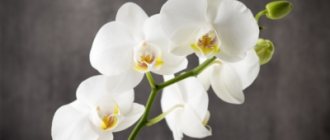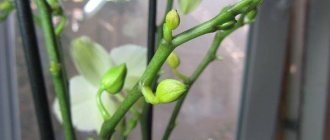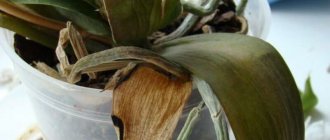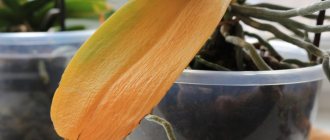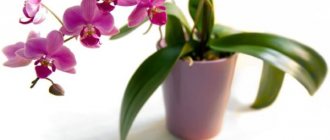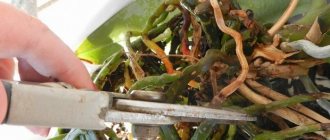The main value of most types of orchids lies in their lush and long-lasting flowering. For the sake of the appearance of magnificent flowers on exotic beauties, flower growers are ready to create tropics in city apartments and fulfill all the whims of the “daughters of the air.”
The biggest trouble for orchid lovers is if all the flowers or buds that are ready to bloom have fallen off, which can happen due to the slightest violation of the care regimen.
To prevent this problem, before purchasing tropical plants, it is advisable to thoroughly study and then carefully follow the recommendations for growing them at home.
Duration of orchid flowering
Each orchid specimen has its own unique flowering schedule: the beginning of bud formation often shifts by month , flowering can occur at any time of the year and more than once per season.
Orchids do not have clear flowering periods.
IMPORTANT! The timing and duration of flowering of an orchid depend on its type and the conditions created for the plant in indoor culture.
Even with proper care, the duration of preservation of the decorative appearance of flowers varies significantly, but on average it is approximately 3 months (a separate corolla can bloom for up to a month). Young orchids most often fade within a month; the flowering of some adult plants takes up to six months or more (if the flower has produced several peduncles, which subsequently bloomed in the second round).
Irises
The watering regime for this crop depends on the time of year. At the beginning of spring and at the end of the season it is reduced. On hot days it is necessary to irrigate irises very abundantly. This should be done in the evenings, when the sun is not too active.
It is preferable to plant some varieties of decorative irises in places with deep groundwater. There is no need to fill them. After flowering, this crop begins a dormant period, and watering should be kept to a minimum.
The difference between natural wilting and dropping flowers
The fall of an orchid's flowers is not always caused by negative reasons. If gradual and smooth fading occurs, which begins from the lower tiers of the peduncle (from the corollas that bloomed first), then this means the natural process of aging of the flowers.
In this case, there is no reason to worry - the plant should be provided with normal care and wait for the next flowering period.
But if the flowers and buds dry and fall off instantly and at the same time, and the plant loses its decorative effect, then this is a sure sign of a violation of the favorable conditions for keeping the tropical beauty.
It is necessary to immediately determine the cause of the trouble and try to minimize the negative consequences.
Methods for preventing and saving peduncles
As you can see, the reason for the shedding of buds and flowers lies in poor care of the plant or failure to maintain the required microclimate in the room. In most cases, wilting of a tropical indoor plant can be prevented.
During the active phase of growth and flowering, the orchid is watered as the substrate dries, but at least once every 7 days. The first sign of a lack of moisture in the soil is considered to be a grayish tint to the root shoots.
If signs of wilting are noticeable, it is recommended to generously spray the crown with settled water at room temperature. At the same time, try to ensure that water does not get into the sinuses of the leaf plates. The accumulation of liquid at the base of the leaf can lead to rotting of the peduncle.
Properly selected lighting, as well as compliance with temperature and air humidity, will help save the peduncle from premature wilting. Do not move the flower pot from one place to another, avoid drafts and other “cataclysms” that are unpleasant for the plant.
What to do if the orchid's flowers have fallen?
The orchid perceives any change in comfortable maintenance parameters as a stressful state and can react by drying out and dropping flowers - the plant enters the survival phase and eliminates all factors that interfere with this process. And since flowering takes too much effort, the buds and flowers of the orchid only get in the way.
It is not possible to stop the process of flower loss in a number of situations. The aging of a plant (over 7 years old), which does not have enough strength to open the formed buds, or the drying of flowers after pollination by random insects is natural and does not cause harm to the plant. The orchid needs standard care until a new shoot forms.
Old orchids often do not have enough strength to open their buds.
The shedding of buds is also irreversible due to the following reasons:
- death of roots from overwatering;
- frostbite of the above-ground part;
- sudden change in conditions of detention.
All flower stalks should be removed to facilitate the orchid's recovery process and care regimens adjusted.
All other factors of improper care that caused the tropical beauty to refuse to bloom can be quickly corrected to stop the buds from falling off and restore interrupted flowering.
A positive effect is achieved by eliminating violations of the watering and fertilizing regime, correcting temperature indicators, air humidity or illumination . It is also necessary to remove bouquets of flowers and fruits from the orchid - the ethylene they produce does not contribute to the opening of the buds.
By quickly diagnosing the reasons for the falling off of orchid buds and flowers and promptly changing the wrong aspects of maintenance, it is possible in some cases to ensure that the tropical beauty continues to bloom.
Such a favorable outcome can be hoped for with very minor and short-term violations of the conditions of detention, as well as with timely elimination of exposure to ethylene from fruits or cut flowers.
If negative changes in the conditions of detention were not detected in time and acted for a long time, this leads to the complete fall of the buds and flowers that have begun to bloom.
A plant damaged in this way requires an assessment of its condition and enhanced care and restoration measures.
Finding out the reason
To ensure proper care and restore regular flowering, it is necessary to find out the reason for the dropping of flowers and buds . This is achieved by visual inspection of the plant and analysis of all care regimens.
At the first stage, the possibility of pollination and the age characteristics of the “daughters of the air” are assessed. If the symptoms fit one of these points, then the orchids are left alone and wait for the next peduncle.
Otherwise, consider possible care errors that cause a stressful state in the plant:
- Lighting primarily affects the release of buds. For normal flowering, the exotic beauty needs bright and diffused light for at least half of the day. This is especially true during the cold season;
For full development, the orchid requires a lot of diffused sunlight.
- Temperature fluctuations in any direction can cause the fall of both blossoming flowers and closed buds. In summer, the cause may be overheating or burns of a plant exposed to direct sunlight for a long time. In winter, there are many more such factors: sudden changes in temperature due to a nearby central heating battery;
- cooling the roots and the plant itself, standing next to a window glass or on a cold windowsill (readings below +15°C are not advisable);
- influence of drafts.
Vegetables and fruits that emit ethylene.
- moving “daughters of the air” from place to place is not the best option for capricious beauties. This may cause flowering failure.
After identifying the cause that led to the loss of flowers, you should immediately begin to adjust the growing conditions.
Growing conditions
It is not always possible to return to standard care indicators after shedding flowers to restore a damaged peduncle, but careful implementation of all regimes will contribute to the rapid formation of new flower shoots.
Optimal lighting
It is created by placing the plant on the east or south side of the house with obligatory shading during the summer afternoon hours, which will save the orchid from burns. In the cold season, illumination with daylight spectrum lamps is required, especially in the evenings.
Exotic beauties are light-loving flowers; they respond positively to the creation of bright, long-lasting and diffused lighting.
Temperature
For comfortable growing of orchids, it should ideally correspond to 23 – 27 °C . To prevent sudden temperature changes, the plant is placed away from radiators and window glass ; in winter, it is good to provide a warm buffer on the windowsill. And be sure to protect your tropical guest from cold drafts.
Air humidity
Should be increased to optimal readings (55 – 70%) using humidifiers or water vessels. Regular “foggy” spraying of leaves in the morning will have a beneficial effect. It is possible to use the double bottom principle in a pot.
Proper watering
It is regulated by visual observation of the orchid: if there is no condensation on the inner surface of the pot, and the protruding roots have slightly changed color to a grayish tint, then it is time to carry out the next watering ( approximately once a week , but with mandatory adjustments due to temperature changes).
Determining the need for watering.
ATTENTION! Water for watering orchids should be warm and settled. Never water the “daughters of the air” with cold water!
Assessing the condition of the peduncle
If, after the massive fall of flowers as a result of care errors, the peduncle does not dry out, retains its erect position and green color, and the dormant buds at its base look alive and healthy, then there are prerequisites for repeated flowering on the same arrow . It is only necessary to adjust the plant’s maintenance regime.
A situation is possible when the top of the peduncle has dried up to half, and then a green stem with swelling dormant buds - meristems - has remained.
In this case, the dried part should be removed , leaving a small dry area (if you cut it down to a living stem, the stopped drying process may resume).
After the normalization of care schedules, the kidneys may give rise to a new arrow or children.
Checking the feasibility of saving the green arrow
In the case when the flowers have fallen, what to do next with the arrow depends on whether it has dried out or remains green. preserved after the flowers have been shed can still be of benefit to the orchid , since there are several dormant buds at its base. Under certain conditions, meristems are capable of forming new flower stalks, which gives reason to hope for repeated flowering.
In addition, meristems can participate in vegetative propagation of an orchid , forming one or more children. Therefore, it is not recommended to remove the green peduncle immediately after all the flowers have fallen off - you should wait for the possible awakening of the buds.
Find out the timing of the final removal of the peduncle
Some flower stalks, after the end of flowering or the unwanted shedding of flowers and buds, are capable of forming new arrows on their stems for more than one year. Therefore, the timing of the final removal of such peduncles may be postponed for several years.
Sometimes a new arrow may begin to grow on a dried peduncle.
ADVICE! It is advisable to cut off any peduncle of a healthy orchid only after it has completely dried naturally.
The healthy green arrow can be removed if necessary: if the plant is severely weakened and requires time to rest and recover.
Temperature and humidity
Orchid is a crop from the humid tropics that loves warmth, but does not tolerate dry air. This means that the room in which the plant is located needs to be ventilated from time to time, but with extreme caution. In summer everything is much simpler, and the orchid can simply be placed on the balcony or outside.
Overheating may be caused if the flower is too close to the air heaters. In this case, it must be pushed to the opposite side of the window sill or placed in a different place altogether. But it is also undesirable to allow such a delicate plant to become overcooled, because this will lead to the leaves falling off. This can happen if the room is cold or it was simply ventilated for a few minutes, and the orchid picked up a draft. Therefore, the room must be carefully ventilated, especially in winter, so that there are no negative consequences for the flower.
If all the buds of an orchid have fallen off, the reason may be due to dry air. Where she comes from, the humidity level is around 60%. To maintain this level, you need air humidifiers or place moistened sand next to the flower. Under the influence of sunlight, moisture evaporates from it, which leads to an increase in moisture around the plant. But you can increase it simply by spraying it with filtered water from a spray bottle. In this case, you need to carefully ensure that drops of moisture do not fall on the leaves and buds, otherwise this will lead to their rotting.
If the soil in the container with the orchid is constantly dry, then the reason is a lack of watering, and if it is waterlogged, it means it was too frequent:
- Improper watering will primarily affect the roots of the plant, which will begin to dry out or rot depending on watering.
- The surviving part of the root system will not be able to give the flower everything that would help it develop normally.
- The plant will begin to distribute moisture from the flowers and buds to the stem and leaves, as a result of which there will be nothing left in the former for further flowering and the plant will gradually dry out.
Experienced gardeners determine the time for the next watering themselves, by touch. When touching the soil, it should be only slightly moistened, but in no case dry or with excess moisture. A significant detail in the irrigation process is that the water must be warm.
There are times when flowers and buds get sunburned. In the summer, the plant is constantly at risk of wilting, since the root system sometimes does not receive the required amount of water and dehydration begins.
Note.
During the heating season, flowers and unopened buds may dry out due to the hot air coming from the heating device. In this case, the pot with the orchid needs to be moved to another place or placed next to the glass, making sure that nothing hangs down or touches the battery.
Possibility of re-blooming
If minor mistakes were made in the maintenance of the orchid and it dropped its flowers, what to do next? In this case, the plant will need some time to recuperate and normalize life processes . Only after this and subject to elimination of defects in care is it possible for the tropical beauty to bloom again.
For the reappearance of buds after the flowers have completely fallen off, it will take a certain time and certain conditions must be met:
- eliminating all mistakes made in orchid care regimens;
- restoring the strength of the plant by carefully following the rules of care;
- growth of green mass by the plant - in monopodial species, the formation of a new peduncle is possible after the growth of the next leaf;
- preservation of the old peduncle from which the flower has fallen, and the presence of viable meristems on it;
- normalization by the plant of flowering periods inherent in each species, subject to their violation.
It is common practice for most orchid species to rebloom after approximately 3 months . Having finished the first flowering or dropping its buds for some reason, the plant begins to build up above-ground mass, which helps it gain strength. After this, a new flower arrow appears or a meristem awakens on a peduncle that has lost flowers.
But if the first flowering occurred at a time that was uncharacteristic for a particular species, then the next formation of flower stalks will occur no earlier than the plant adjusts the timing of its flowering.
Plant care before flowering
To prevent the occurrence of a number of problems associated with orchid flowering, you need to know what factors influence this process.
Lighting
Illumination is one of the main conditions for good growth and flowering of an orchid:
- places with diffused sunlight , since direct rays can cause burns on the leaves, drying out the roots and drying out of the buds;
- During periods of short daylight hours, it is recommended to install illumination with phytolamps.
Additional illumination using a phytolamp.
Low illumination of the orchid in the winter and autumn seasons determines the absence of flowering during this period.
Watering
One of the most common reasons for the death of buds is a violation of the watering regime:
- with weak watering, dry roots compensate for the lack of water by redistributing moisture from other parts of the plant, including buds;
- Excessive watering leads to infection and rotting of the root system.
With further spread of root rot, the development of the peduncle is delayed and it dies off along with the buds that did not have time to open.
Substrate
When preparing a substrate for transplantation, orchids are guided by indoor conditions, primarily humidity and light. To do this, add more or less moisture-absorbing sphagnum moss to the soil mixture.
For apartments with low humidity, a soil mixture of pine bark, charcoal, moss and foam balls (5:1:1:1) is suitable.
An equally important characteristic is the acidity (pH) of the soil.
How to determine soil acidity?
Alkalinization of the soil, like excess acidity, will have negative consequences.
Attention! The optimal pH level of the substrate should be 5.5-6.0, that is, the environment should be slightly acidic. Neutral soil has an acidity of 7.0.
Setting the soil pH level at home is quite simple:
- soil reaction to acetic acid . Place a handful of soil on a newspaper or in a small container and add 1 tbsp to it. l. vinegar. The reaction of lime with acid releases carbon dioxide. If, when adding vinegar, a small number of bubbles form on the surface of the soil, then the acidity level is low. Lack of reaction means the soil is highly acidic;
- inspection of the substrate surface. If, after watering a flower, water leaves yellow-brown stains on the surface of the soil, this indicates its increased acidity;
- The use of litmus papers is a fairly accurate method for assessing pH levels. You can purchase indicator kits in pharmacies or specialty stores. The kit also includes a reference color scale showing the dependence of acidity on the color of the paper strip.
Litmus paper is the most accurate way to determine acidity.
Knowing the acidity level of the substrate, you can adjust this indicator to the optimum.
How to avoid alkalization?
Alkalinization of the soil and roots often produces a dry, whitish coating along the edge of the flower pot . To remove it, it is enough to soak the orchid once in a mixture of distillate and boiled water, taken in equal parts.
The composition of the soil mixture for orchids usually includes bark and sphagnum moss, which have a pH of 4.0-4.5; they give the mixtures low acidity. If there is a need to adjust the acidity level when preparing the soil mixture, you need to know that:
- when adding charcoal, the pH of the substrate increases , which has a positive effect on the growth of orchids;
- To reduce the acidity sphagnum moss or peat to it
Adding additives will delay the alkalization of the substrate due to watering with hard water.
Rules for watering and fertilizing
When flowers fall off due to flooding of the plant, this means that the root system is damaged . The orchid should be replanted, while treating the roots (remove damaged areas and disinfect). After this, do not water for about 10 days, and then carefully follow the watering schedule - once a week, allowing the substrate to dry.
The flooded orchid should first be replanted.
If replanting is not carried out, then the flooded plant, which has lost its color, should first be dried and then gradually introduced to the correct watering regime.
When shedding flowers from drying out soil, the orchid is first soldered by immersing the pot in a vessel with water , and then the watering schedule is normalized.
The same rules apply to fertilizing. If an orchid has dropped its flowers due to overfeeding, then you should try to wash out excess fertilizer from the soil or replace the substrate.
CAREFULLY! After replanting a plant that has stopped flowering due to excessive fertilization, fertilizing should not be applied for 3 to 6 months.
The lack of nutrition that led to the fall of the buds should be replenished gradually. It is necessary to adjust the feeding schedule and apply it once a month with watering, using half the dose indicated on the package.
Honeysuckle Honeysuckle
Infrequent but abundant watering is recommended for this crop. Honeysuckle honeysuckle is sensitive to soil moisture. The soil around the plant should never dry out completely.
Usually honeysuckle is watered at least 3 times in one month. If the weather is hot and dry, plants need to be watered more often. After watering, the soil is loosened or covered with a layer of dry leaves. Can be used for mulching and humus. A layer of mulch prevents the evaporation of moisture from the soil and is a good top dressing.
Need for transplant
If a plant loses its color as a result of problems with the root system, then the question arises about the need to replant the specimen. Orchid roots can be damaged by various factors.
Improper watering leads to rotting (with frequent watering) or drying out (with insufficient moisture) of the underground part. The roots gradually die off; they do not have enough strength to provide the green mass with water and nutrition.
The plant is forced to give up flowers in order to survive. In this case, transplantation and root treatment are vital.
Sometimes, if the substrate is not selected correctly, a whitish dry coating forms on the protruding parts of the root and the edges of the flowerpot. This is a sign of alkalization , which can lead to flower drop. To improve growing conditions, the plant is recommended to be replanted.
Main signs of developmental delay
Sometimes it happens that an orchid has buds, but does not bloom. Signs of this are:
- delay in bud development for a period of at least 2 months ;
- falling of unopened buds;
- wilting or drying of buds.
This problem is associated with improper maintenance conditions or care and is typical for novice gardeners.
Resetting flowers after purchasing in a store
Moving a plant from a store to an apartment after purchasing it can be called a highly stressful state. Therefore, it is not at all surprising that the orchid reacts to this by losing flowers and buds.
Causes of the phenomenon
Color reset after purchase in a store may be due to several reasons:
- the plant was exposed to stress due to the move;
- when purchased in winter and not properly packaged, frostbite occurs on the delicate buds;
- The orchid in the store bloomed for quite a long time, and the dropping of flowers in the apartment is simply the natural aging of the corollas.
An orchid may drop its flowers after purchase for various reasons.
ADVICE! In order for an orchid to delight you with its flowering for a long time after purchase, you need to choose specimens with the least number of open buds.
Risk reduction
To help an orchid survive the stress associated with the purchase, you should thoroughly think through the possible risks and try to anticipate all difficulties.
It is better to purchase the plant in summer and in calm weather.
When purchasing in winter, you need to stock up on special packaging material and transport the tropical beauty by car. Upon arrival home, you should immediately locate the plant in a permanent place and leave it without watering and with sufficient lighting for acclimatization.
Stress and damage
A change in usual conditions can also be the reason if the orchid’s flowers have fallen. In this case, the flower is put back in its place or they try to recreate the conditions that it had before the rearrangement, because then it will begin to come back to life and bloom again. It is because of this that orchids are not rearranged, and during flowering they are not touched at all. From poor access to light and unsuitable air temperature, the plant can also become stressed and begin to crumble.
If the buds of a phalaenopsis fall off, you can put fruits and vegetables nearby. They contain ethylene gas, which, on the contrary, is beneficial for growth and promotes the rapid opening of buds. A cut bouquet, which gradually begins to fade, has a similar effect.
You may be interested in:
How to properly prune an orchid after flowering: basic pruning rules Orchids such as phalaenopsis bloom twice a year. The period lasts about two weeks, and another type of it...Read more...
The reason that an orchid drops its flowers is that then its flowering period quickly ends and the plant subsequently withers. To prevent such accelerated aging from happening again, apples and other fruits and vegetables are not placed next to phalaenopsis.
The cause may be articles and damage:
- Brown and black spots appear on flowers and buds if they are caught.
- The leaves can be damaged during transportation if the pot accidentally falls or the plant is found by pets.
- Due to such damage, the leaves of the flower turn yellow and the flower itself dries out.
You need to carefully look after the orchid and protect it from injury, because nothing can be done with the damaged parts, and all that remains is to cut them off.
Solutions to the problem
Orchid loves fresh air. Therefore, cigarette smoke and exhaust gases from the street can negatively affect her condition. When pollinated by insects, it withers and a seed pod appears.
| Problem | Solution |
| Improper watering | During flowering, more frequent watering is required. If several buds have dried out without blooming, increase watering. Overwatering leads to gradual rotting of the roots and shedding of leaves. |
| Overheat | In summer, block the window with blinds and paper. During the heating season, cover the area of the radiator above which the orchid is located with a towel. |
| Hypothermia | When transporting in winter, the plant is carefully packed in polyethylene and paper. If it’s frosty outside and the orchid is standing on the windowsill, touching the glass, move it away. |
| Lighting | During the flowering period, provide 10 to 14 hours of daylight. Use lamps in autumn and winter. Short daylight hours put the plant into a dormant state. It is not recommended to change the orchid's orientation to the light. |
| Humidity | Place a container with sand or expanded clay near the orchid and pour water. Under the influence of the sun and the heat of the battery, the moisture evaporates and enters the flower. Spraying and a humidifier will also solve the problem of insufficient humidity. |
| Damage | Replant the plant carefully, being careful not to damage it. When transporting, pack in cellophane in a box. |
| Draft | lack of ventilation Do not place the flower in the path of cool air currents, especially in winter. The cold is destructive for them. |
| Stress | Determine one stable location for the orchid and do not move it, especially during flowering. |
| Fertilizers | When there is an excess of nitrogen, mealybugs appear on the plant. Do not use fertilizers unless necessary. |
| Diseases | The diseased flower is set aside from other indoor plants. If damaged by pests, treat with insecticides, garlic water, and soap solution. |
